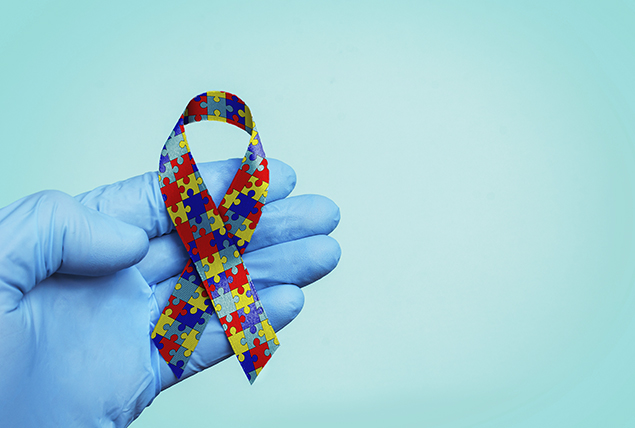Let's Dispel Some Myths and Dispense Some Facts About Autism

Autism spectrum disorder (ASD) is a broad condition defined by a set of characteristics and symptoms that deviate from the norm. More than 5.4 million Americans have been diagnosed with autism—that number growing as the medical community learns more about the disorder—so everyone should understand how autism presents and how it is diagnosed.
The signs of ASD typically begin to manifest early; the average age at diagnosis is 4 to 5 years old, according to a 2020 meta-analysis published in the journal Autism. Many adults, however, go years without diagnosis due to previous misunderstandings about the condition, lack of awareness and stigma.
In previous decades, some medical professionals may have wanted to wait before pronouncing an ASD diagnosis, but doctors now prioritize early diagnosis so treatment can start when autistic children are young.
"The days of 'let's wait and see' should be over," said David Berger, M.D., a pediatrician and the founder of Wholistic Pediatrics & Family Care in Tampa, Florida. "There are critical developmental skills that need to be supported as soon as possible."
Autism symptoms
Autism is a spectrum disorder, which means that each autistic person has a unique pattern of behavior, strengths and challenges. In the past, medical professionals categorized autism into five different types, but they now recognize the condition as a continuous spectrum.
"One thing to always keep in mind is the wide array of people who are on the autism spectrum," Berger said. "Some have no expressive or receptive communication abilities; some are limited in speech or can only get what they need by leading people by the hand. Yet others can communicate with no perceivable difference. The same is true for other symptoms of autism."
Autism can present in many different ways, but common symptoms include:
- Difficulty with social interaction and communication
- Poor eye contact
- Tendency to be alone or in "their own world"
- Delayed or minimal speech
- Different or minimal expression of emotions
- Inappropriate social disruptions
- Difficulty understanding social cues
- Performs repetitive motions
- Has specific rituals or habits
- Sensitive to sound, light, texture or other factors
- Has specific food preferences
Each person with autism may exhibit many symptoms or only a few, and there is a wide range of severity within these symptoms. Some autistic individuals can function very well in society and manage their symptoms with relative ease, while others may need additional support.
"It is critical to take an individualized approach to people with autism to best support their strengths and work with them on their challenges," Berger said.
Autism and sexual development
While ASD can impact social and neurological development, the condition doesn't have any impact on sexual development. Autistic teenagers develop sexual interest and feelings just like their non-autistic peers do.
However, reading social cues and interacting socially can be difficult for some autistic people. So autistic adolescents often need to be taught consent and guided in the social skills needed to successfully have romantic relationships (if that's what they wish).
A common misconception is that autistic people have a lower libido than other people, but that's untrue.
"I am not aware of any connection between autism and a lower sex drive," said Julian Lagoy, M.D., a psychiatrist with Mindpath Health in San Jose, California. "Autism is primarily a social disorder and may impact a person's ability to have a relationship with sex; however, autism biologically has nothing to do with sex drive."
Autistic individuals reported a desire for more sexual education and more practical guidance on how to navigate real-world situations, according to a 2021 Front Psychology study.
A 2015 analysis suggested similar results. It indicated that people with autism could benefit from sex education that does the following:
- Normalizes differences (e.g., in identities and experiences of sexuality)
- Is offered throughout young adulthood
- Addresses disability-relevant sensory and communication needs
- Includes practicing neurotypical sociosexual norms
How ASD is diagnosed
Most cases of autism are diagnosed at a young age, as signs of ASD are typically noticeable by about age 2. If you're a parent and notice delays in your child's language skills and social interactions, you should make an appointment with your doctor. They can perform developmental tests on your child and assess their condition.
"Early intervention is critical to optimize the long-term function of a person with autism," Berger said. "That is why we screen for autism with the MCHAT test during checkups between 18 and 30 months of age. But often, symptoms are seen sooner."
The MCHAT test is a checklist for toddlers that parents can use to assess their child's behavior. Questions cover a child's interests, sensitivities, mobility and more.
"If a parent has any concern that a child has lost developmental or social skills, or has stopped making progress or if there are any flags, the child should be assessed," Berger said.
No genetic test or blood screening can confirm autism. While genetic mutations do play a part in 40 percent to 80 percent of ASD risk, according to MedlinePlus, there is no way to definitively determine autism based on a person's genes.
Diagnosing adults with autism is a little more difficult. Many people are deep into their adult lives before they are diagnosed. Adult diagnosis is possible, however, and a qualified psychologist or psychiatrist can determine if someone has ASD.
An autism assessment for adults relies on a person's understanding of how they interact with the world, others' reports of behavior or symptoms, self-screening questionnaires and clinical observations.
Self-screening questionnaires are common. The three primary ones are as follows:
- Adult Social Behavior Questionnaire (ASBQ). This test has 44 questions and is especially helpful for diagnosing low-severity ASD.
- Adult Repetitive Behaviors Questionnaire-2 (RBQ-2A). This 20-question test focuses on repetitive and restricted behaviors to determine if someone has ASD.
- Autism Spectrum Quotient (AQ-10). This questionnaire is common and contains 10 questions, although some research found it lacking as a sole tool for diagnosis.
Diagnosing adults with ASD can be difficult because the disorder can look like a lot of other conditions, such as social communication disorder (SCD) and anxiety.
It's common for adults with ASD to suffer from other conditions, too. A 2019 meta-analysis published in The Lancet found adults with ASD shared other diagnoses, such as:
- 28 percent were also diagnosed with attention-deficit disorder.
- 20 percent of autistic adults have an anxiety disorder.
- 13 percent were also diagnosed with sleep-wake disorders.
- 12 percent of autistic adults have disruptive, impulse-control and conduct disorders.
- 11 percent suffered from a depressive disorder.
- 9 percent were diagnosed with obsessive-compulsive disorder (OCD).
- 5 percent suffered from bipolar disorder.
Adults with a late diagnosis of autism are often considered high-functioning since they were potentially able to navigate adulthood. This doesn't mean adulthood was easy for them—and handling social situations, careers and other aspects of growing up may have been a struggle. A diagnosis, even late in life, can help validate feelings of social insecurities or difficulties that a person with autism has faced.
The consequences of undiagnosed ASD
Undiagnosed ASD can have serious consequences for autistic individuals.
"Consequences include difficulty living independently, higher risk of being unemployed and difficulty with relationships," Lagoy said. "There is also [a] risk to mental and physical health."
Feelings of otherness and an inability to connect with no understood "reason" can cause mental health concerns. Once a person is diagnosed, they can work with professionals to assess their abilities and be given support and tools to navigate through life.
Untreated autism can lead to brain changes that may make it difficult for an individual with autism to control their impulses. Such control issues can make living independently and working challenging or impossible, according to ACES, an autism therapy center.
Struggling with social interaction is a common symptom of ASD, and individuals with autism can work through these social difficulties with therapy and tools given to them early in life. Delaying that support can make social situations more difficult as an adult.
"Early intervention is critical to optimize the long-term function of a person with autism," Berger said.
If you think your child may have autism, it's best to get them evaluated as soon as possible so they can avoid any potential long-term problems as an adult.
Myths and misconceptions about autism
Misunderstandings about ASD abound, and it's easy to believe false information when it's everywhere—so let's set some myths straight.
Myth No. 1: Vaccines cause autism
The National Academy of Medicine reviewed eight common childhood vaccines and determined them to be safe. A 2013 CDC study added to the large number of studies that have found no connection between vaccines and autism.
Myth No. 2: People with autism are 'Einsteins'
Many autistic individuals have special interests and skills, but autism does not necessarily equal intelligence. Autistic people are just like everyone else, and their intelligence and abilities are present on a wide spectrum.
Myth No. 3: Autism is only seen in children
While autism is commonly diagnosed in children, ASD is a lifelong disorder. There is no cure for autism, just management strategies.
Myth No. 4: Autistic people are antisocial
A common symptom of ASD is difficulty with social interaction and communication. That does not mean, however, that autistic people don't want social interaction or relationships.
Myth No. 5: Autism only affects boys
Boys are at least four times more likely to be diagnosed with autism than girls. However, girls have autism, too. ASD can present differently in girls than in boys, which can lead to difficulty diagnosing autism in females.
Autism is complicated. It's a broad spectrum of conditions and symptoms that range in severity. Breaking down the myths and misconceptions about ASD is a crucial step in building overall awareness about this commonly diagnosed condition.


















